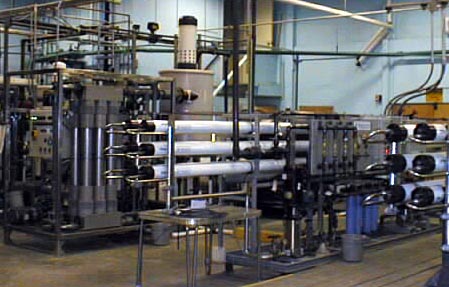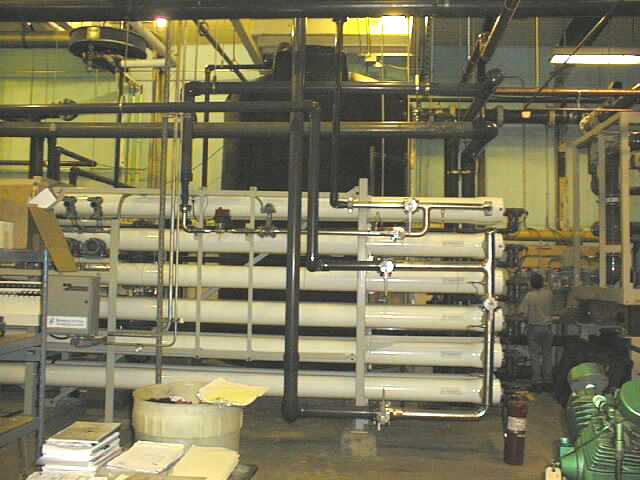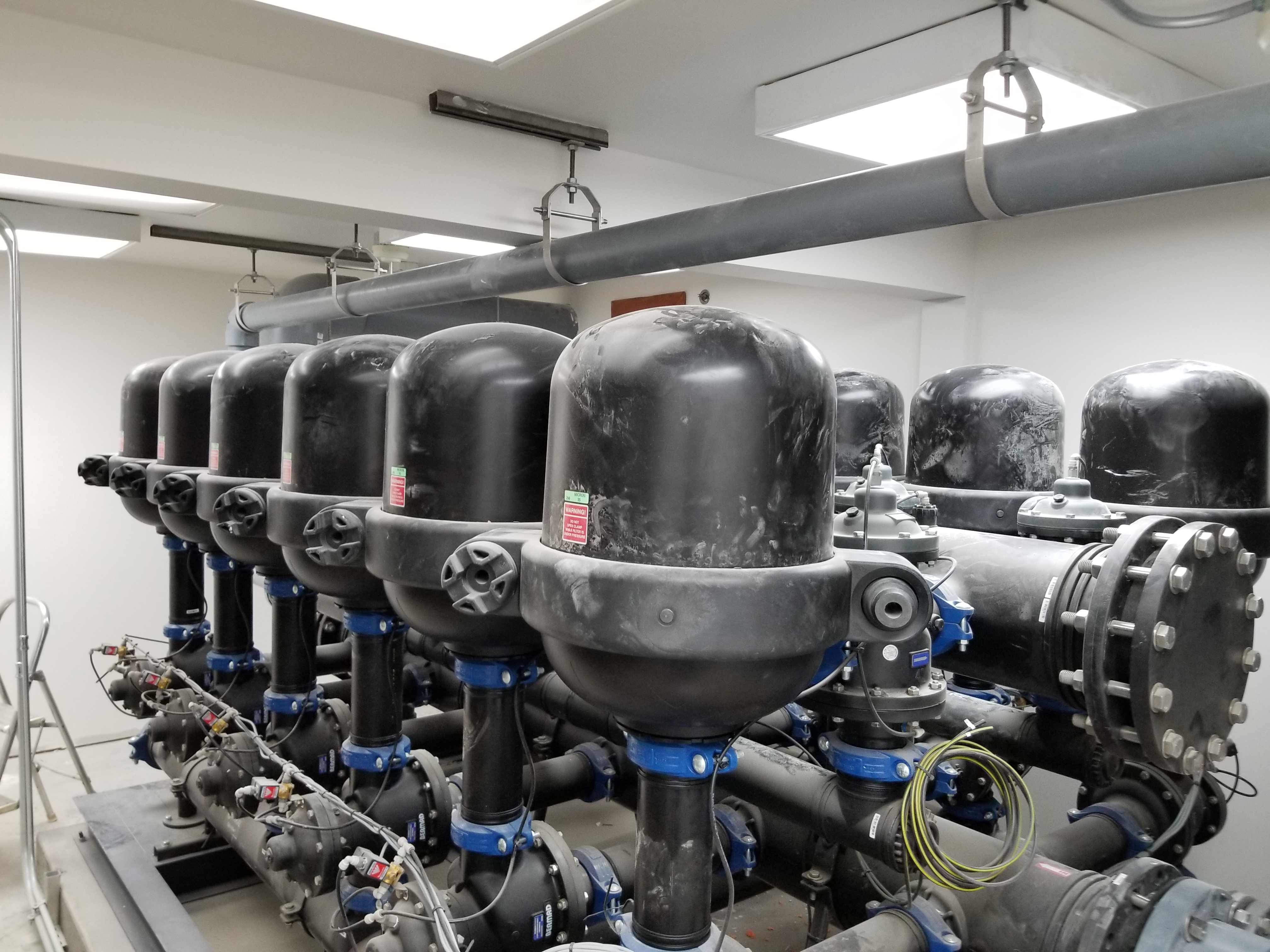Barrow Utilities and Electric, Co-op, Inc., Dual Membrane System
Barrow, Alaska, residents are served by the Barrow Utilities and Electric Co-op, Inc. (BUECI), for water, wastewater, and power. In 1998, BUECI decided to improve the water treatment system.
 GV Jones and Associates performed a pilot study for BUECI to determine the effectiveness of the dual membrane system at treating the surface water in the Isatkoak Reservoir, which serves as the communities source water. The source has color and algae issues. The intent of the dual membrane was to remove disinfection-by-product precursors, which can be an issue in surface water sources that have high organics levels. The microfiltration removes particulates and organisms by physical separation. The pilot skids were installed in the building and produced water that was not sent to distribution. The pilot study lasted for 1 year and the data collected was used to size the equipment as well as determine the approriate operating modes, such as cleaning regimens and likely membrane replacement intervals. Piloting efforts can also help designers determine what kind of pre and post treatment will be most beneficial to the system. At BUECI, The pilot study showed that the microfilter was effective at remvoing algae and sediment. The filtrate from the microfilter pilot skid was sent to the nanofiltration pilot skid. Prior experiences indicated that nanofiltration is an effective method of removing the organics that are common disinfection-by-product precursors. The pilot study showed a significant reduction in the formation of disinfection-by-products after the nanofiltration skid.
GV Jones and Associates performed a pilot study for BUECI to determine the effectiveness of the dual membrane system at treating the surface water in the Isatkoak Reservoir, which serves as the communities source water. The source has color and algae issues. The intent of the dual membrane was to remove disinfection-by-product precursors, which can be an issue in surface water sources that have high organics levels. The microfiltration removes particulates and organisms by physical separation. The pilot skids were installed in the building and produced water that was not sent to distribution. The pilot study lasted for 1 year and the data collected was used to size the equipment as well as determine the approriate operating modes, such as cleaning regimens and likely membrane replacement intervals. Piloting efforts can also help designers determine what kind of pre and post treatment will be most beneficial to the system. At BUECI, The pilot study showed that the microfilter was effective at remvoing algae and sediment. The filtrate from the microfilter pilot skid was sent to the nanofiltration pilot skid. Prior experiences indicated that nanofiltration is an effective method of removing the organics that are common disinfection-by-product precursors. The pilot study showed a significant reduction in the formation of disinfection-by-products after the nanofiltration skid.
 Since the outcome of the piloting effort was positive, BUECI decided to have GVJ&A design a full sized dual membrane system. The system that was designed and installed has a maximum operating production of about 240 GPM. In membrane systems, the designers must remember to account for removal and replacement of the membranes, which requires an additional clearance at the ends of the pressure vessels. Also important to the design are considerations for future growth. The system is designed so that an identical train of both microfiltration and ultrafiltration units could be set inparallel to the current units. Typically designers will look at past community growth to determine the most likely groth rate for the community. A typical value in Alaska is between 3 and 5 percent, although some smaller villages can be much lower. Even if historical growth is lower than 3%, GVJ&A will use a value of at least 3%.
Since the outcome of the piloting effort was positive, BUECI decided to have GVJ&A design a full sized dual membrane system. The system that was designed and installed has a maximum operating production of about 240 GPM. In membrane systems, the designers must remember to account for removal and replacement of the membranes, which requires an additional clearance at the ends of the pressure vessels. Also important to the design are considerations for future growth. The system is designed so that an identical train of both microfiltration and ultrafiltration units could be set inparallel to the current units. Typically designers will look at past community growth to determine the most likely groth rate for the community. A typical value in Alaska is between 3 and 5 percent, although some smaller villages can be much lower. Even if historical growth is lower than 3%, GVJ&A will use a value of at least 3%.
 The dual membrane system was installed in 2001 and has been producing quality potable water to Barrow citizens since then. The system is monitored for disinfection-by-products on a quarterly basis and the results have been very good. Prior to the system installation, disinfection-by-product concentrations were as high as 100 µg/L TTHM and 59 µg/LHAA5 and as low as 23 µg/L TTHM and 4.6 µg/L HAA5. After installation of the dual membrane system, concentrations reach as high as 20 µg/L TTHM and 26.1 µg/L HAA%, although the typical values are lower than 10 µg/L TTHM and 3 µg/L HAA5. The disinfection-by-product concetraion starts to go up when the membranes need changed. The current DBP Rule maximum contaminant level is 80 µg/L TTHM and 60 µg/L HAA5.
The dual membrane system was installed in 2001 and has been producing quality potable water to Barrow citizens since then. The system is monitored for disinfection-by-products on a quarterly basis and the results have been very good. Prior to the system installation, disinfection-by-product concentrations were as high as 100 µg/L TTHM and 59 µg/LHAA5 and as low as 23 µg/L TTHM and 4.6 µg/L HAA5. After installation of the dual membrane system, concentrations reach as high as 20 µg/L TTHM and 26.1 µg/L HAA%, although the typical values are lower than 10 µg/L TTHM and 3 µg/L HAA5. The disinfection-by-product concetraion starts to go up when the membranes need changed. The current DBP Rule maximum contaminant level is 80 µg/L TTHM and 60 µg/L HAA5.
Between 2012 and 2016 staged upgrades were completed to expand the original dual membrane capacity from 240 gpm to 480 gpm by adding an additional skid of NF and of MF capacity. These upgrades included modifications to raw water pumping capacity, raw water heating capacity, treated water storage tanks, treated water conveyance, and raw water intake screening. The final stage of the upgrade was to install the second NF train and the second MF skid. However, the MF technology had changed since the original 1998 project. The ultrafiltration (UF) membranes are capable of operating at lower feed pressures and can remove a higher percentage of organic material. In order to ensure continued removal of the DBP precursors with the new membranes and operational parameters, BUECI decided to undertake a piloting effort during the summer of 2016. The pilot data confirmed that the UF membranes were performing as well or better than the UF membranes. In the fall of 2017, the design of the two-train dual-membrane system was completed. The existing NF skid was replicated, but the existing MF skid was replaced with a UF skid and a second UF skid was added. The equipment was purchased by BUECI in order to complete the design using the most accurate shop drawings possible. Construction was complete between September 2018 and March 2019.
Since startup of the new skids, BUECI has enjoyed the ability to take the system off line more often and complete maintenance tasks that would have previously caused concern about re-filling the storage tanks.
 |
||
| Amiad Disc Filter Skid | NF Skid | UF Skid |
